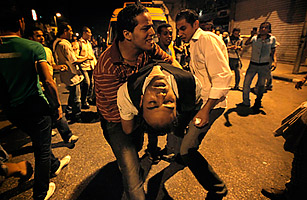
Tahrir Square on Wednesday, a day after another round of clashes between police and protesters, resembled its old war-zone self. Crowds of Egyptians trampled over the broken shards of glass and pavement that littered the street outside Cairo’s interior ministry. Tear gas lingered in the air, as the remains of burning tires cooled near the lines of military police who had arrived when the regular police made their familiar exit. Traffic moved haltingly through the swarms of spectators. And then there were the vendors who had wheeled in their juice and snack carts to capitalize on the crowds.
Few who participated know how the latest clashes began, but in the climate of economic and political uncertainty of post-Mubarak Egypt, where everyone has a grievance to air, the experience is likely to repeated many times over. The question is, will Egypt’s interim military rulers make an effort to mitigate the damage and the frequency of such instances by breaking with the old regime’s habits.
After an all-night battle of stones, rubber bullets, Molotov cocktails and tear gas, many of the protesters and civilian spectators who were present say they’re even angrier than they had been before. “I was sitting at a coffee shop last night when I heard about problems in Tahrir,” says Walid Safwat, an unemployed college graduate. “I came running and I saw the same scene that we had seen on January 25th.” With a fresh head bandage, Safwat is among the protesters who reported injuries from police-fired rubber bullets in the early hours of Tuesday morning. “I’m one of the revolutionary protesters,” he says, “So when we find central security hitting us the way they did before, we feel as if the revolution didn’t accomplish anything.”
But it also remains unclear — even to Safwat and most others who joined the fight how exactly the whole thing got started, and what its specific objectives had been. “I don’t know how it started, but we heard the families of the martyrs were here protesting and that one of the martyr’s mothers was taken away by police,” says Safwat. He came to express solidarity with the victims’ families, he says. Others came to demand police compensation. Still others called for an end to military rule.
One thing is certain: Family members of the Egyptians killed during the 18-day winter uprising that toppled President Hosni Mubarak had been demonstrating on Tuesday afternoon, when they ran into harassment by security forces. The families had grown frustrated by the slow pace and laxity with which former security officials have been prosecuted for their crimes. Ex-Interior Minister Habib al-Adly’s trial was adjourned on June 26 for the third time, prompting the angry families of victims to hurl rocks at the truck suspected of carrying him. And Mohamed Ibrahim Abdel Monem — who on June 27 became the first policeman to be sentenced for killing protesters during the uprising — is not yet in custody.
See the top 10 most influential protests.
See inside Egypt’s state security headquarters.